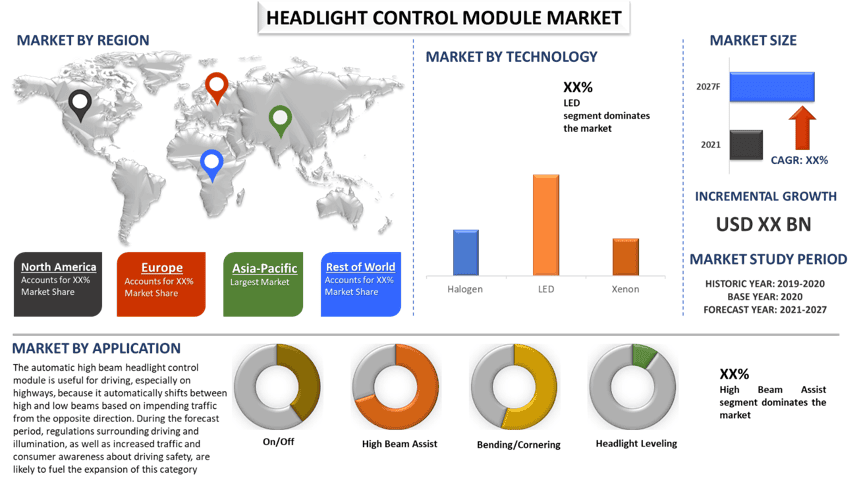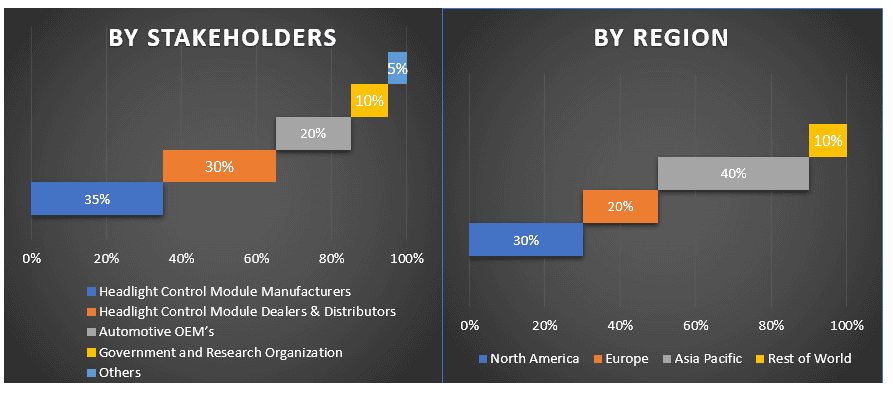- Accueil
- À propos de nous
- Industrie
- Services
- Lecture
- Contactez-nous
Marché des modules de commande de phares : Analyse actuelle et prévisions (2021-2027)
Accent mis sur la technologie (halogène, LED et xénon) ; Application (marche/arrêt, virage/directionnel, assistant feux de route et réglage de la hauteur des phares) ; Véhicule (voiture particulière et véhicule utilitaire léger) ; Région et pays

Le marché mondial des modules de commande de phares devrait afficher un TCAC d'environ 4 % au cours de la période de prévision (2021-2027). Un module de commande de phares de véhicule est un composant électrique qui régule l'éclairage. Le module aide à réguler le fonctionnement des phares et des klaxons en fournissant un faisceau de route automatique. Il peut être modifié entre un faisceau de lumière faible et un faisceau de lumière élevée en fonction de l'autre direction pour mesurer la distance entre les automobiles avant pendant le trafic avec l'utilisation d'une caméra vidéo. Le marché devrait croître à mesure que les fabricants adoptent des modules de commande de phares, qui sont extrêmement utiles lors de la conduite d'un véhicule, en particulier sur l'autoroute, où il a tendance à basculer entre les feux de croisement et les feux de route en réponse à la circulation venant en sens inverse, ainsi qu'en raison des préoccupations croissantes concernant la sécurité routière.
Aperçus présentés dans le rapport
« Parmi les technologies, le segment des LED a dominé le marché en 2020 »
Selon la technologie, le marché est segmenté en halogène, LED et xénon. Le segment des LED devrait croître à un TCAC plus élevé au cours de la période de prévision. Les phares à LED sont souvent utilisés dans les automobiles haut de gamme en raison de leurs nombreux avantages, notamment une consommation d'énergie plus faible, des fonctions plus adaptables et une apparence visuellement agréable. Les LED sont le principal marché des modules de commande de phares en raison de ces qualités, et cette tendance devrait se poursuivre à l'avenir.
« Parmi les applications, le segment High Beam Assist a dominé le marché en 2020. »
Selon l'application, le marché est segmenté en On/Off, Bending/Cornering, High Beam Assist et Headlight Leveling. Le segment High Beam Assist devrait croître à un TCAC plus élevé au cours de la période de prévision. Le module de commande automatique des phares à faisceau de route est utile pour la conduite, en particulier sur les autoroutes, car il bascule automatiquement entre les faisceaux de route et de croisement en fonction de la circulation imminente venant en sens inverse. Au cours de la période de prévision, les réglementations concernant la conduite et l'éclairage, ainsi que l'augmentation du trafic et la sensibilisation des consommateurs à la sécurité de la conduite, sont susceptibles d'alimenter l'expansion de cette catégorie.
« Parmi les véhicules, le segment des voitures particulières a dominé le marché en 2020. »
Selon le véhicule, le marché est segmenté en voitures particulières et véhicules utilitaires légers. Le segment des voitures particulières devrait croître à un TCAC plus élevé au cours de la période de prévision. La pénétration des phares adaptatifs est plus élevée dans la catégorie des voitures particulières que dans le segment des véhicules utilitaires légers. Le marché de cette catégorie est susceptible d'être tiré par l'augmentation des ventes de voitures particulières et la volonté des clients de dépenser plus pour les automobiles personnelles.
« L'Asie-Pacifique représente le plus grand marché. »
Selon l'estimation, au cours de la période de projection 2021-2027, l'Asie-Pacifique devrait croître à un TCAC plus élevé. En raison de l'adoption accrue par les consommateurs et des ventes automobiles, l'Asie-Pacifique devrait se développer au rythme le plus rapide sur le marché mondial des modules de commande de phares. En raison de leur énorme production et de leurs ventes automobiles nationales, la Chine et le Japon détiennent les parts de marché les plus importantes. En outre, les fabricants de ces pays mettent fortement l'accent sur les améliorations technologiques, en particulier l'éclairage, ce qui stimule la demande de modules de commande de phares. Le marché serait encore plus stimulé par l'augmentation du revenu par habitant des consommateurs et les fortes ventes de VUS sur les marchés émergents comme l'Inde. En raison de l'augmentation des ventes d'automobiles de luxe, il y a eu un besoin considérable de commande de phares. L'utilisation accrue de ces modules dans les véhicules des segments inférieur et intermédiaire est susceptible de créer de nouvelles possibilités de croissance du marché dans cette région au cours de la période de prévision. Parmi les principaux acteurs opérant sur le marché, citons Hella KGaA Hueck & Co., Valeo, Continental AG, DENSO Corporation, Aptiv plc, Magneti Marelli, Renesas Electronics Corporation, Lear Corporation, NXP Semiconductors N.V., Koito Manufacturing Co Ltd, etc.
Raisons d'acheter ce rapport :
- L'étude comprend une analyse de la taille et des prévisions du marché validée par des experts clés authentifiés du secteur
- Le rapport présente un aperçu rapide de la performance globale de l'industrie en un coup d'œil
- Le rapport couvre une analyse approfondie des principaux pairs de l'industrie en mettant l'accent sur les principaux éléments financiers, le portefeuille de produits, les stratégies d'expansion et les développements récents
- Examen détaillé des moteurs, des contraintes, des tendances clés et des opportunités qui prévalent dans l'industrie
- L'étude couvre de manière exhaustive le marché à travers différents segments
- Analyse approfondie de l'industrie aux niveaux régional et national
Options de personnalisation :
Le module mondial de commande de phares peut être personnalisé davantage selon les besoins ou tout autre segment de marché. En outre, UMI comprend que vous pouvez avoir vos propres besoins commerciaux, alors n'hésitez pas à communiquer avec nous pour obtenir un rapport qui répond parfaitement à vos besoins.
Table des matières
L'un des principaux facteurs à l'origine de la croissance du marché des modules de commande de phares est l'augmentation des ventes de voitures de luxe et de SUV au sein de la population mondiale. Le marché devrait croître en raison de l'adoption croissante des modules de commande de phares par les fabricants, qui sont extrêmement utiles lors de la conduite d'un véhicule, en particulier sur l'autoroute, où ils ont tendance à basculer entre les feux de croisement et les feux de route en réponse à la circulation venant en sens inverse, ainsi qu'en raison des préoccupations croissantes concernant la sécurité routière. Les progrès des fabricants en matière de technologie d'éclairage, ainsi que le besoin croissant de réduire la consommation d'énergie de leurs voitures, ont un impact significatif sur le marché. En outre, l'évolution des préférences des consommateurs, l'augmentation du revenu disponible, l'augmentation de la production et des ventes de véhicules, l'urbanisation et l'utilisation accrue dans la fabrication de véhicules électriques profitent tous au marché des modules de commande de phares.
La production et la consommation d'automobiles et de véhicules électriques ont un impact direct sur le module de commande d'éclairage, car les phares sont une caractéristique essentielle de ces véhicules. Le besoin de modules de commande de phares devrait être stimulé par les progrès de la technologie d'éclairage réalisés par divers fabricants. Le marché des modules de commande de phares devrait croître en réponse aux avancées de la technologie des véhicules ainsi qu'à l'augmentation des investissements des constructeurs automobiles. La crise énergétique imminente, ainsi que la nécessité de réduire les émissions de gaz à effet de serre, ont incité les constructeurs automobiles à déployer des efforts considérables pour réduire la consommation d'énergie de leurs véhicules, et ils développent actuellement des véhicules entièrement ou partiellement alimentés à l'électricité, ce qui devrait stimuler la demande de véhicules électriques et hybrides et avoir un impact indirect sur le marché des modules de commande de phares. Le désir des consommateurs d'améliorer l'apparence extérieure, la sécurité et les fonctions de conduite avancées devrait stimuler le marché mondial des modules de commande de phares.
Analyse de la taille historique du marché
Étape 1 : Étude approfondie des sources secondaires :
Une étude secondaire détaillée a été menée pour obtenir la taille historique du marché des modules de commande de phares grâce à des sources internes à l'entreprise, telles que les rapports annuels et les états financiers, les présentations de performances, les communiqués de presse, etc., et des sources externes, notamment les revues, les actualités et les articles, les publications gouvernementales, les publications des concurrents, les rapports sectoriels, les bases de données tierces et d'autres publications crédibles.
Étape 2 : Segmentation du marché :
Après avoir obtenu la taille historique du marché des modules de commande de phares, nous avons mené une analyse secondaire détaillée pour recueillir des informations sur le marché historique et partager les différents segments et sous-segments pour les principales régions. Les principaux segments inclus dans le rapport sont par technologie, application, véhicule. D'autres analyses régionales et nationales ont été menées pour évaluer l'adoption globale du module de commande de phares dans le contexte mondial.
Étape 3 : Analyse des facteurs :
Après avoir acquis la taille historique du marché des différents segments et sous-segments, nous avons mené une analyse des facteurs détaillée pour estimer la taille actuelle du marché. De plus, nous avons mené une analyse des facteurs en utilisant des variables dépendantes et indépendantes telles que les incitations gouvernementales croissantes et la demande de transports écologiques, etc. Les tendances historiques et leur impact d'une année sur l'autre sur la taille et la part de marché ont été analysés. Le scénario de l'offre et de la demande a également été étudié de manière approfondie.
Estimation et prévision de la taille actuelle du marché
Taille actuelle du marché : Sur la base des informations exploitables tirées des 3 étapes ci-dessus, nous sommes arrivés à la taille actuelle du marché, aux principaux acteurs du marché et aux parts de marché des segments et des entreprises. Toutes les divisions en pourcentage requises et les répartitions du marché ont été déterminées à l'aide de l'approche secondaire susmentionnée et ont été vérifiées par le biais d'entretiens primaires.
Estimation et prévision : Pour l'estimation et la prévision du marché, des pondérations ont été attribuées à différents facteurs, notamment les moteurs et les tendances, les contraintes et les opportunités disponibles pour les parties prenantes. Après avoir analysé ces facteurs, des techniques de prévision pertinentes, c'est-à-dire une approche ascendante, ont été appliquées pour parvenir à la prévision du marché jusqu'en 2027 pour différents segments et sous-segments dans les principales régions du monde. La méthodologie de recherche adoptée pour estimer la taille du marché comprend :
- La taille du marché de l'industrie, en termes de valeur (US$) et le taux d'adoption du module de commande de phares sur les principaux marchés
- Toutes les parts de pourcentage, les divisions et les répartitions des segments et sous-segments du marché
- Les principaux acteurs du module de commande de phares en termes de produits proposés. De plus, les stratégies de croissance adoptées par ces acteurs pour concurrencer sur le marché en forte croissance.
Validation de la taille et de la part du marché
Recherche primaire : Des entretiens approfondis ont été menés avec les principaux leaders d'opinion (KOL), y compris les cadres supérieurs (CXO/VP, chef des ventes, chef du marketing, chef des opérations et chef régional, chef de pays, etc.) dans les principaux pays. Les résultats de la recherche primaire ont ensuite été résumés et une analyse statistique a été effectuée pour prouver l'hypothèse énoncée. Les contributions de la recherche primaire ont été consolidées avec les résultats secondaires, transformant ainsi l'information en informations exploitables.
Répartition des participants primaires dans différentes régions
Ingénierie du marché
La technique de triangulation des données a été utilisée pour compléter l'estimation globale du marché et pour arriver à des chiffres statistiques précis de chaque segment et sous-segment du module de commande de phares. Les données ont été divisées en plusieurs segments et sous-segments après avoir étudié divers paramètres et tendances dans les domaines du type de service, du type de véhicule et de la région.
L'objectif principal de l'étude sur le module de commande de phares
Les tendances actuelles et futures du marché du module de commande de phares ont été mises en évidence dans l'étude. Les investisseurs peuvent obtenir des informations stratégiques pour fonder leur discrétion en matière d'investissements à partir de l'analyse qualitative et quantitative effectuée dans l'étude. Les tendances actuelles et futures du marché détermineraient l'attractivité globale du marché au niveau régional et national, offrant une plateforme aux participants industriels pour exploiter le marché inexploité afin de bénéficier d'un avantage de premier plan. Les autres objectifs quantitatifs des études comprennent :
- Analyser la taille actuelle et prévisionnelle du marché du module de commande de phares en termes de valeur (US$). Analyser également la taille actuelle et prévisionnelle du marché des différents segments et sous-segments
- Les segments de l'étude comprennent le type, l'application et le véhicule
- Analyse définie du cadre réglementaire de l'industrie mondiale des modules de commande de phares
- Analyser la chaîne de valeur impliquée avec la présence de divers intermédiaires, ainsi qu'analyser les comportements des clients et des concurrents de l'industrie
- Analyser la taille actuelle et prévisionnelle du marché du module de commande de phares pour les principales régions et pays
- Les principales régions étudiées dans le rapport comprennent l'Amérique du Nord (États-Unis, Canada, reste de l'Amérique du Nord), l'Europe (Allemagne, Royaume-Uni, France, Italie, Espagne, reste de l'Europe), l'Asie-Pacifique (Chine, Japon, Inde, Corée du Sud, reste de l'Asie-Pacifique) et le reste du monde
- Profils d'entreprise des acteurs du module de commande de phares et des stratégies de croissance adoptées par eux pour se maintenir sur le marché en forte croissance
Analyse approfondie au niveau régional et national de l'industrie
Connexes Rapports
Les clients qui ont acheté cet article ont également acheté










